Graduates in their 20s who made career advancements
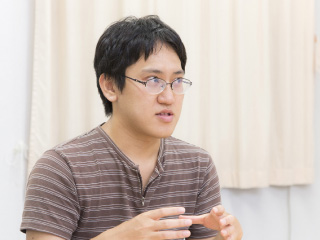
Mr. OZAKI Satoshi
PROFILE
Trend Micro Inc.
Graduated from the Graduate School of Kyoto University
Completed the Master Program of Information Systems Architecture in 2015.
Nurturing the senses of IT to go outside my domain.
Studying the present state of IT as it evolves in corporations from faculty members and other students.
I studied the physical properties of plastics and earned a master's degree at university. Although I was employed by an IT security firm, I had never studied computers and the Internet in depth before entering the company. My company offered training for new employees, but because I wanted to establish a foundation for my work in my own way, I decided to study at AIIT where I could still work full time.
I also anticipated that I could learn the reality of the IT industry, which is what types of systems corporations set up for IT, from professors with practical experience and other students who are professionals in the industry. In fact, I was able to acquire knowledge about servers in companies, on which outside people have less access to that information.
Deepening the understanding of IT through synergistic training and classwork.
After entering the company, I went to school while being trained at the company for a while. I was very busy, but overcame the hardships with my tolerance reinforced for a busy schedule. There was a synergetic effect of learning simultaneously both at the company and at school. The training provided knowledge that I could immediately use at work. The classes at AIIT supplemented the basic information, which helped me deepen my understanding while connecting the academic foundation to practical skills. In addition, for the virtual machine, which I did not study at all in the training and which I had more opportunities to use at AIIT, I started using virtual machines more frequently at work later. Today, I can handle it flexibly because I have a basic understanding that I gained at AIIT.
AIIT offered classes that were always ahead of my work.
Looking back over the two years at AIIT, the most memorable part was the PBL where I completed a project with six team members with different backgrounds. The theme we worked on was the automatic judgment of privacy violations in videos. We began by discussing the definition of the videos that infringe privacy to develop a proof of concept (POC) that determines the images using movie analysis techniques. During the development process, we had the chance to make a presentation outside the school and exchanged opinions with experts. I capitalized on the technology of machine learning handled within the project in my work later. As with the virtual machine, what I had learned at AIIT was always ahead of my work. In addition, the experience of completing a project helped develop the perspective to deduce the next development at work. Once I was able to predict what was to come, I could accurately determine the whereabouts of a problem that occurred unexpectedly and deal with it, which developed my confidence at work. Because the classwork at AIIT helped nurture the sense of IT, which was outside of my domain at the time of enrolling, I can focus on daily tasks with a solid background.
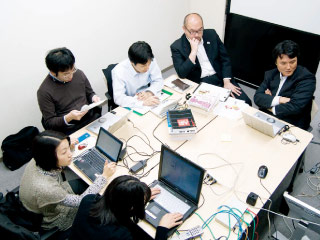
Mr. KANETA Keiichi
PROFILE
Murakami Corporation
Graduated from Shizuoka University.
Completed the Master Program of Innovation for Design and Engineering in 2016.
Inspirational AIIT has changed my personality.
Studying at a university in Tokyo is convenient for job hunting.
After studying electrical and electronic engineering at Shizuoka University, I enrolled at AIIT. Although most of my classmates advanced to graduate school at Shizuoka University, I was attracted to study at a professional graduate school, instead of continuing research in my domain.
I thought I could also learn from the experience of working with students who were currently professionals and a wide range of people from all over the country. In addition, I wanted to get a job in Shizuoka. I thought that being in Tokyo offered more opportunities to attend the briefing sessions provided by companies outside Tokyo. I thought it was still possible to find a job in Shizuoka. Now, I work from my parents' house, and I am convinced that I made the right decision, because that I learned more than I expected in the beginning in just two years, not because that I was hired by a local company as I had hoped. Especially after experiencing PBL and many other group projects, I became a person with a positive attitude. I also became aware that I can take the initiative in working on projects.
Surrounded by reactions with a sense of speed.
I was the type of person who followed others until my undergraduate studies. Despite such a personality, I did not feel any obstacles when I worked on my graduation research at a lab at university where the order of precedence among students was clear. However, in PBL, the project does not move forward unless the entire team takes the initiative in fulfilling their roles. When my classmates, who worked full time, pointed it out, I retrospectively evaluated and changed my attitude. I also imitated the actions of professionals as students, which was what I thought I wanted to become in terms of how to proceed with a project and how to communicate the attraction of a project theme. Doing so helped me to become a person with a positive attitude.
Once I started taking the initiative and being involved in a project and speaking up, I started getting instant reactions. To keep up with a sense of speed that I had never experienced in my undergraduate studies, and my ability to respond naturally improved. The PBL classes improved my communication skills, and after the middle of the project, I was able to take charge of negotiations with partner companies for trial production and the presentation of project results to outside AIIT.
I wanted to fuse my learning to capitalize on new business.
The project I worked on in PBL was the development and application of a multifaceted imaging system using polarization. This theme eventually worked as a bridge between the electrical and electronic engineering I studied at university and the company that hired me.
The company I work for has the largest share of the production of mirrors for vehicles in Japan. Even so, the mirrors will inevitably be replaced with a camera system in the future. This development requires technologies related to electrical and electronic engineering, optics, and visualization. In PBL, I also studied software development from professionals. By demonstrating my abilities to fuse together these technologies, I would like to be more deeply involved in my company's new business.
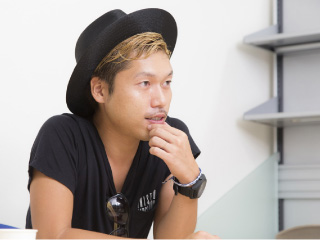
Mr. SHIMAZAKI Yusuke
PROFILE
Nissan Motor Co., Ltd.
Graduated from HAL Tokyo.
Completed the Master Program of Innovation for Design and Engineering in 2015.
A compass leads me to what I want to be.
Although I clearly envisioned my goals, I did not know the route to get there.
I wanted a job that left a legacy in the world. This vague dream that I set in my teens narrowed down to automobiles when I entered an engineering university fresh out of high school. I majored in management engineering, and there I saw the practical exercise of designing automobiles using 3D CAD software in another course, which materialized what I wanted to do.
Even so, I did not have any experience in design. I left the university to enroll in a technical school to learn basic drawing techniques.
Although my manual skills improved, I was left dissatisfied and worried. While I could imagine my ideal job as a professional designer in the creative field, I did not know how to get there. I enrolled at AIIT because I thought I lacked the fundamental element. My goal was to deepen my way of thinking of design to connect my skills to what was in my head.
The pursuit of coolness was staged in a new perspective.
The classes at AIIT focus on group projects from the first year. It was refreshing to work with people from different generations and backgrounds. We recognized each other's strengths and weaknesses to achieve one objective by dividing the work between us. The PBL in the second year was an extension of the group projects. My team devised compact-size mobility devices that could be used at the 2020 Summer Olympics in Tokyo.
In parallel with the classwork, I explored what I was missing to become a professional designer. Professors, who have made enormous achievements in the development of vehicles, teach at AIIT. I focused on sending my work to the automobile industry every week for strict evaluations, which was self-imposed. By repeating this, I learned to develop the perspective of imagining the lives of riders and their emotions, which added to the pursuit of coolness. This made me feel that the design was connected to the community.
My communication skills were highly praised by an automobile company.
Today, I work in the design studio of an automobile company. Honestly, I knew that my sketching skills were inferior to people who graduated from an art college and with whom I competed in job hunting. The skills that my company liked were my communication skills, which were developed in group projects at AIIT. I took part in a cross-sectional team for crafting design strategies, which became a company's identity, because my company recognized my strength in collaborating with people from other fields.
I appreciate AIIT for showing me how to make my dream come true even though people told me it was impossible. My thoughts after becoming a professional designer are that the image of what I want to become is only a process. Now, I am putting myself into my work daily to further upgrade my skills.
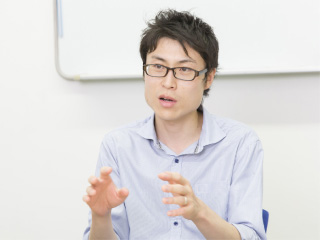
Mr. NAKATANI Jun
PROFILE
An electric vehicle manufacturer for the overseas market
Graduated from Keio University.
Completed the Master Program of Innovation for Design and Engineering in 2010.
The two years I needed to make my dream come true.
After graduating from university and a technical college, I enrolled at AIIT.
Once I obtained my driver's license, I had the idea of working at an automobile manufacturer. Because I studied in the faculty of economics, I was unfamiliar with engineering. After graduating from university, I enrolled in a technical school to study automobile design to acquire knowledge about automobile structure, how to use machine tools, and how to operate 3D CAD software. Even so, I wanted more than acquiring manufacturing and design skills, and I sought ways to learn the theory of monozukuri. I left a technical college to enroll at AIIT. I hoped to expand my vision of automobile development by using my knowledge of business strategy theories and industrial organization theories acquired from the faculty of economics, as well as the manufacturing and design skills acquired in a technical college, at the core by studying at AIIT.
The method I learned in class is still useful at work.
In the first year, I studied extensively the skills related to development and design, embedded systems, and design. In class, I felt that being exposed to theories in line with actual practice prepared me to build a firm background to the manufacturing skills I acquired at technical college.
The classwork of two subjects, Management of Technology and Reliability Engineering, left me with vivid memories even now. The Management of Technology taught me the categories of the basic design concept in monozukuri along with actual examples. This subject helped clarify the direction that I should go in the future by understanding the characteristics of monozukuri in the field I wanted to pursue. In addition, Reliability Engineering taught me methods of preventing problems in product development to ensure the reliability of products using familiar household appliances as an example. I use this method to design automobile systems that I am working on at present. It provides me with the awareness to consider users and the market because, as an engineer, I tend to focus on the pursuit of technology and advanced functions.
The theories I learned in the first year were put into
practice in PBL in the second year.
After studying the general theories of product development in the first year, I worked on a team to develop a new technology by putting the theories into practice in the second year. The theme assigned to my team was the expansion of the application of a pressure sensor. We constructed authentication technology to measure the pressure of the bottom of the foot to determine individuals when stepping on sensors on a sheet.
After completing the program at AIIT, I was hired by a developer of brake systems. Without the support of AIIT, I would not have found a job-AIIT turned the fact that it was three years after completing my undergraduate studies into a strength amidst a job shortage after Lehman's fall. Today, I work at a company that develops and manufactures electric vehicles for the overseas market. Although it is a company run by fewer, more capable personnel like a studio, I find that the job of creating a car in the company is rewarding.
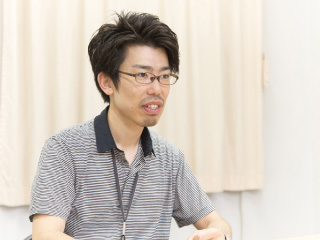
Mr. HIRAO Yasuyuki
PROFILE
Sony Mobile Communications Inc.
Graduated from the Graduate School of Osaka University.Completed the Master Program of Innovation for Design and Engineering in 2012.
AIIT helped me acquire an objective perspective for me to overlook monozukuri from a broad point of view.
Organizing knowledge acquired through experience.
There are two major achievements I gained from learning at AIIT. One is that I learned the process of monozukuri academically. Another is to acquire a variety of perspectives toward design and the method to evaluate design objectively.
Since I studied bioengineering at university, I did not have the opportunity to study the design and production of electrical products and digital devices. My experience in programming only focused on research. And, research differs from software development for cell phones.
Because of this, I acquired knowledge and skills for development on the job as needed from time to time. Although it is practical in terms of being directly connected to work, my knowledge was not structured, and I could not overlook product development from a broad perspective. Because of this, it was wasteful, and I even lacked the foundation to determine whether trial and error were indispensable or not.
I wanted to refine my knowledge of monozukuri and organize what I had acquired from experience to make rational advances. With hope, I was looking for a place where I could study while working full time.
I submitted a proposal for new business with my classmates at AIIT.
After spending two years at AIIT, I believe I achieved the goal I set in the beginning. For monozukuri at work and by logically understanding the process of product development, I was able to pay attention to each phase from the determination of specifications, sorting of the requirements, and design to implementation without missing key points.
In addition, by acquiring a method to guarantee reliability and quality for design, as well as a method to verify similarities with other products, I was able to seek product uniqueness based on an objective view even at work. Furthermore, as a result of viewing monozukuri from a broader perspective, I became interested in the planning of business and products. I also submitted my ideas to the new business creation program in my company. This is something I could never have imagined doing before studying at AIIT because I was groping in the darkness in the past.
In addition, my classmates at AIIT took part as external members to help me with my proposal, which was shortlisted in the end. I continued to keep in touch with classmates whether for business or personal reasons. Although they work in different fields, AIIT gave me the opportunity to meet with peers who earnestly work on monozukuri. They are a valuable asset in my life.
I also visit the Shinagawa campus frequently even after completing the program. This is because I use the library at AIIT, which houses extensive selections of technical books. For me, AIIT became a place for lifelong learning that goes beyond the achievement of my goals in the beginning.
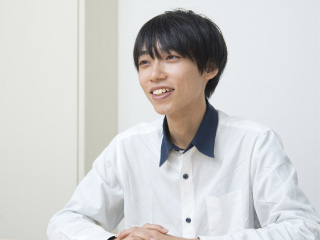
Mr. FURUHATA Naoki
PROFILE
Design Research Center, Mitsubishi Electric Corporation
Graduated from Tokyo Metropolitan University
Completed the Master Program of Innovation for Design and Engineering in 2010.
A new domain of design for incorporating different fields.
Learning the fusion of engineering and design.
I advanced to the faculty of engineering with the hope of creating something tangible at work. It was around the time when I earnestly started considering whether to get a job or advance to graduate school after graduating when I learned that there was a job called product designer. Once my views for work were mapped out, I became aware of the difference between the studies I majored in and the job I wanted to do. I advanced to AIIT because I wanted to develop my perspective of extensively grasping monozukuri, instead of continuing to increase my expertise. It meant turning my pivot from engineering to design.
Even so, the reason why I did not go to a graduate school for the arts was that I wanted to have an impact as an engineer. The monozukuri taught in the Master Program of Innovation for Design and Engineering, which fuses together engineering and design, was the job I wanted to tackle.
Learning cutting-edge monozukuri by getting ahead of the times.
What I noticed after enrolling in the program at AIIT was the difference in thinking processes between engineering and design. While engineering leads to results by accumulating feasible technologies, design presents a goal first by putting the process aside. For instance, the making out of 100 ideas, taking the accidentalness which engineering deny into usable account, is used to explore feasible approaches to design. In addition, after gathering a variety of ideas and just before reaching a conclusion, design tries to find a resolution by untangling the ideas. Learning this type of design thinking and HCD (human-centered design), as known as the keywords in cutting-edge monozukuri at that time, became my strength after getting a job. In addition, PBL in collaboration with Itabashi Ward was another valuable experience. Product designers often work with people from different fields. Even across different fields, they share the same objective of pursuing corporate culture and profits. In this sense, it is easier to understand others when compared to a PBL project, where I worked with team members with no common grounds other than classmates at AIIT. It could be because I studied quality engineering and control engineering with design at AIIT.
Getting involved in planning as a designer.
After completing the program at AIIT, I was hired by a manufacturer specializing in peripheral equipment for computers. There, I specialize in the UI design for storage products and applications. Because AIIT taught me the enjoyment of becoming involved from the planning phase, I was also involved in new projects as a designer. After that, I changed my jobs to work at an electronics company, and I am currently in charge of the design of products for the public. While I question the value of design in society, I want to continue taking on the challenge of a new sector of design, which incorporates engineering and different fields.
